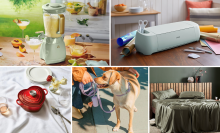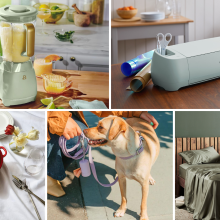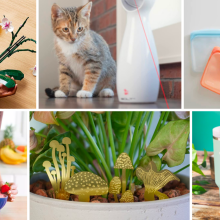Everyone wants to be able to make their favorite coffee shop drinks in the comfort of their own home these days. After all, trying to keep up with a thrice-daily Starbucks habit... in this economy? No, thanks. So brewing at home helps us save a little (okay, a lot) of money and grants us unfettered access to tasty caffeine concoctions to fuel our busy days, especially when working from home. Win-win, right?
Well, sort of. In order to make coffee drinks that are actually comparable — or maybe even better — than the liquid gold deliciousness poured at your favorite local coffee shop, you'll need to stock your at-home coffee bar with some key tools, such as a milk frother or steamer.
What is a milk frother?
These special, yet generally affordable tools help you create frothy steamed milk and cold foam to top your lattes, cappuccinos, cold brews, iced matcha tea lattes, and more. However, there are a few different types of frothers to choose from — and each one works in different ways — so we're breaking it all down to help you find the best milk frother for your coffee-drinking pleasure.
What types of milk frothers are there?
Milk frothers and steamers come in a few different forms, and you'll want to consider the types of coffee drinks you like to make before deciding on which one is best for you.
Electric milk frothers. Sometimes called “automatic milk frothers,” these plug-in appliances not only froth but also create heated milk, since hot milk is often easier to turn into froth. They tend to have options for fluffy foam versus dense foam, and they typically are able to create cold foam, too. They can also steam milk without frothing it, which opens the door for many other types of hot coffee drinks — and hot chocolate as well!
The gold standard of electric milk frothers is typically thought to be Smeg, which is really no surprise given the fact that the stylish brand's retro-aesthetic kitchen appliances tend to top any design-conscious decorator's list. The only downside is that Smeg is hella expensive.
The high price tag might be justifiable for the brand's refrigerators or blenders, but for a relatively simple appliance that just does one thing? No, ma'am — a nearly $300 milk frother is just not the vibe. Same goes for the expert-recommended Breville Milk Cafe Milk Frother which seems like a bargain at half the price of Smeg, but is still pretty steep for most folks to rationalize.
Fortunately, there are lots of dupes and alternatives out there that are far more affordable, and they work just as well. (They might be a little less cute, but hey, that's the sacrifice we make.)
Handheld frothers. These battery-powered tools create lots of air bubbles to froth your milk, kind of like a tiny electric whisk. However, they don’t heat your milk, so if you want a hot foam, you’ll first have to bring your milk up to temperature on the stovetop or in the microwave. (Bonus: They can also be used to whip eggs, blend protein powder or matcha tea powder with liquid, stir keto coffee concoctions and more.)
Manual milk frothers. These contraptions look like a French press and, alternatively, you could use your French press to froth milk in the same way. You'll have to put a little muscle into it, though, pumping the froth-making plunger up to 90 times until you feel the milk getting thicker. At that point, you might as well churn your own butter too — but these manual devices are still a good choice for travel and camping.
Can milk frothers make cold foam?
You can absolutely make cold foam with a milk frother! But first, let's jump into what cold foam actually is, and what makes it different from steamed frothiness.
In the simplest terms, cold foam is a frothed milk topping for iced coffee drinks, aka the cold equivalent of the steamed milk froth that tops hot lattes and cappuccinos. If you tried to put that steamy froth on a cold drink, however, it would just melt right into the drink. On the flipside, cold froth will sit right on top, get comfy and just settle in as you enjoy each sip. It's almost like adding a decadent whipped topping straight from the can, but with far fewer calories.
So yes, you can make cold foam at home, but the best milk frother for the job may be a handheld option. While electric frothers can make cold foam too, they tend to be more expensive than handheld frothers since they also have the ability to steam milk. So the latter may be a more economical choice for those who prefer cold milk foam and cold coffee drinks.
Alternatively, you could use a manual milk frother or even a French press to pump the milk into a cold foam. And keep in mind that your choice of milk can have an effect on the consistency of your cold foam, too.
Will different types of milk create a different froth?
To get some expert insight into best frothing practices — and get the lowdown on the cold foam trend — we spoke to Aaron Contreras of Volcanica Coffee, an online specialty coffee roaster that imports over 150 exotic coffees from volcanic regions around the world.
"Lighter and thinner milk typically produce the best frothed cold foams," says Contreras. "[This is] because they produce microbubbles in the texture that is reminiscent of that thick, velvety sort of taste people tend to look for in their cold foam froth."
Depending on your drink of choice (and whether you like to sip hot or cold brews), you may prefer a steamed milk froth rather than a cold foam. In that case, you’ll want to opt for a different milk to get the best result.
"Lattes and cappuccinos taste better with milk that has a higher fat and lipid content, [while] cold foam froth is best done with 2% (sometimes even non-fat milk) to produce a lighter, frothier sort of body that will easily sit on top of the beverage," says Contreras. "Almond milk and oat milk are thick and don't work as well foamed cold, but thinner non-dairies like soy and coconut milk tend to do well."
Can you use non-dairy milk with a milk frother?
Typically, the frothiest results come from milks that are high in fat, but some milk frothers — handheld milk frothers, in particular — are quite good at frothing milk alternatives that have a lower fat content, such as nut milks, seed milks, oat milks, soy milks and coconut milks. And, as Contreras noted, sticking to non-dairy milks with a thinner consistency will work best when creating cold foam with a milk frother.
Are handheld milk frothers more difficult to use than electric milk frothers?
Not really! Though it’s hard to beat the sheer simplicity of a one-button-touch automatic milk frother, their handheld counterparts are still incredibly easy to use. That said, there are a few expert tips to keep in mind.
"In terms of technique, it's mostly being able to aerate the milk throughout," says Contreras. "[When using] a handheld frother, place it right under the surface (but not too far down into the body of the milk), turn it on to get that swirl going, and then gently push the frother into the body of the milk."
So there you have it. Whether you like your frothed milk from a dairy source or a milk alternative, steamed or whipped into a cold foam, one of these affordable milk frothers is sure to elevate your home-brewed coffee drinks to café status in no time.


























